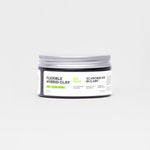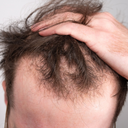The world of hair styling products has long embraced petrolatum for its many benefits for hair. Known for providing shine, moisture, and the ability to hold and shape the hair, petrolatum has definitely become a go-to ingredient in the hair care industry.
However, there is a critical aspect often overlooked: its long-term effects of hair health. In this article, we’ll explore the potential downsides of petrolatum and its alternatives that could help you create long-lasting styles without the negatives associated with it.
Table of content
Summary
Petrolatum, derived from petroleum jelly, is a popular ingredient in hair styling products thanks to its several benefits, including its moisturising properties, ability to provide shine and a strong hold. However, these don't come without undesirable downsides.
Petrolatum is a sticky, water-resistant substance. This is what gives it its ability to hold styles. But this same quality also makes it hard to wash out, leaving a sticky residue and buildup on the hair. Studies suggest that the long-term use of such substances can lead to greasiness, dullness, scalp irritation, and dandruff.
While petrolatum is generally considered safe, we created formulas for our styling clay-waxes using plant-based alternatives to petrolatum for your peace of mind. The natural waxes in our Firm Hybrid Clay and Flexible Hybrid Clay aim to provide a long-lasting hold and are easy to wash out to help you avoid the downsides associated with the use of non-water-soluble substances.
As your leading source for hair health information over the past 4 years, we never compromise on accuracy. When it comes to your health, you deserve information you can truly rely on - and earning your trust is our top priority.
Here's how Scandinavian Biolabs ensures every piece of content meets the highest standards of accuracy and integrity:
- Credentialed Experts: Our reviewers are actively practicing doctors and medical researchers
- Stringent Reviews: Content undergoes rigorous editing by subject specialists and review by a practicing doctor.
- Evidence-Based: We rely on well-established research from trusted scientific sources like peer-reviewed journals and health authorities.
- Full Transparency: Our editorial standards, writer credentials, reviewer credentials, correction process, and funding are all publicly documented.
- Independent Voice: While we do promote products, we operate in a vacuum to business operations. Our main goal is just an unwavering commitment to providing medically-sound guidance.
You can count on Scandinavian Biolabs to consistently deliver the trustworthy health information you deserve. Read our Editorial Standards.
What is petrolatum and why is it a popular ingredient in styling products?
Petrolatum, derived from petroleum jelly, has earned its popularity in hair styling products for several reasons. Its occlusive nature [1] makes it an effective moisturising agent, sealing in moisture and preventing water loss [2] from the hair shaft. Additionally, petrolatum imparts a glossy shine, which contributes to a polished finish in various hairstyles.
But perhaps the most pivotal role petrolatum plays in styling products is providing a hold thanks to its sticky nature. When applied to the hair, petrolatum sticks to the hair shaft and creates a film, providing structure and definition to the hairstyle. While this helps create long-lasting styles, it can also lead to a host of problems with long-term use.

The potential issues caused by petrolatum
Difficult to wash out
While its consistency is important for preventing water loss, and defining the hair, the crucial aspect that sets petrolatum apart is its non-water-soluble nature. Namely, several studies have demonstrated the resistance of petrolatum to water, making it challenging to wash out with conventional water-based cleansers [3,4]. In fact, petrolatum is used in the treatment of several skin conditions, such as contact dermatitis, as a protector from water-loss thanks to its water resistant nature [5].
Adhesiveness to hair strands and sticky feeling
Research also indicates that petrolatum exhibits strong adhesiveness to hair strands, leading to a sticky, tacky feeling that persists even after attempted hair washouts. This is similar to heavier oils that are not soluble in water and may leave hair weighed-down, even after a thorough cleanse.
Buildup on hair and scalp
Consequently, the difficulty in washing out petrolatum can result in a buildup on both hair strands and the scalp. Studies have linked prolonged use of non-water-soluble substances to concerns [6], such as buildup, dullness, heaviness, potential scalp irritation, and dandruff.

What are the alternatives?
Recognising the drawbacks associated with petrolatum, it is important to find the ingredients and hair product formulas that offer a thoughtful selection of natural alternatives, ensuring effective hair styling without compromising hair (and scalp) health. There are several alternative ingredients petrolatum-free formulas may include, such as:
Kaolin clay
Kaolin clay is known for its definition and lightweight hold and provides structure to hairstyles without the stickiness associated with petrolatum. Besides providing a lightweight hold, it also adds texture to the hair [7].
Plant-based wax blends
The inclusion of some plant-based waxes [8] in the formulas can mimic the adhesive properties of petrolatum while also offering easy washability, avoiding the sticky residue left by non-water-soluble ingredients. We’ll briefly present wax alternatives to petrolatum.
Carnauba wax
Carnauba wax, derived from the leaves of the Brazilian palm tree, Copernicia prunifera, stands out for its versatile properties and natural origins. It is known for its firmness, providing structure and hold to styling products, making it ideal for shaping and defining hairstyles, while also forming a protective barrier on the hair shaft, reducing hair damage and keeping frizz at bay.
Sunflower seed wax
Extracted from sunflower (Helianthus annus) seeds, sunflower seed wax contributes to a smooth texture and consistency in hair products, ensuring easy application and even distribution. It also helps seal in moisture, keeping the hair hydrated. It provides a flexible hold, without stiffness or crunchiness.
Candelilla wax
Obtained from the leaves of the candelilla (Euphorbia cerifera) shrub, candelilla wax offers a host of benefits for hair styling products, particularly due to its firmness. It provides structure and hold to hairstyles, facilitating shaping and definition. It adds a smooth and creamy texture, enhancing the application experience.
What other ingredients can be useful in styling products?
The number one job of a styling product — not surprisingly — is to help you create various styles and hold them in place. But that doesn’t have to be the only job it does. In fact, many styling products today aim to do double or triple duty by helping to nourish, protect, and strengthen your strands. So let’s take a look at a few useful ingredients that can help with that.
Sea buckthorn
The essential fatty acids and antioxidants in Sea buckthorn contribute to the hair protection from damage. Namely, sea buckthorn is rich in omega-3 and omega-6 fatty acids, both essential for maintaining healthy hair which contribute to hydration, nourishment, and protection against environmental damage [9]. Studies support its moisturizing properties, providing an alternative to petrolatum's moisture-retention capabilities.
Quinoa
Quinoa, rich in protein and amino acids, aids in repairing hair damage, offering a natural alternative to the hair benefits associated with petrolatum. Therefore, it represents a great addition to the hair care formulas.
Rosemary leaf
Rosemary leaf helps soothe and revitalize the scalp. Studies suggest its potential in promoting scalp health, aligning with the holistic approach to hair care, as rosemary has anti-inflammatory and antioxidant properties [10].
It is always important to be mindful of what ingredients we use on our scalp. But this is especially true if you are experiencing hair loss or hair thinning. The scalp is crucial for hair growth, therefore, the better its condition, the better your chances at hair growth. Products which are non-water soluble, such as those containing petrolatum, will worsen the looks of your thinning hair by weighing it down.
Therefore, understanding the non-water-soluble nature of petrolatum sheds light on its challenges, and - instead of hair products containing petrolatum, choose formulas enriched with natural alternatives, which not only provide effective styling but also address these challenges, offering a cleaner, more comfortable, and nourishing styling experience.
References:
[1] Pinto JR, Monteiro E Silva SA, Holsback VSS, Leonardi GR. Skin occlusive performance: Sustainable alternatives for petrolatum in skincare formulations. J Cosmet Dermatol. 2022 Oct;21(10):4775-4780. doi: 10.1111/jocd.14782. Epub 2022 Jan 26. PMID: 35038372.
[2] Kamrani P, Hedrick J, Marks JG, Zaenglein AL. Petroleum jelly: A comprehensive review of its history, uses, and safety. J Am Acad Dermatol. 2023 Jun 12:S0190-9622(23)01107-6. doi: 10.1016/j.jaad.2023.06.010. Epub ahead of print. PMID: 37315800.
[3] De Paepe K, Sieg A, Le Meur M, Rogiers V. Silicones as nonocclusive topical agents. Skin Pharmacol Physiol. 2014;27(3):164-71. doi: 10.1159/000354914. Epub 2014 Jan 18. PMID: 24457536.
[4] McGee JS, Kirkorian AY, Pappert AS, Milgraum SS. An adolescent boy with urticaria to water: review of current treatments for aquagenic urticaria. Pediatr Dermatol. 2014 Jan-Feb;31(1):116-7. doi: 10.1111/j.1525-1470.2012.01801.x. Epub 2012 Sep 20. PMID: 22994854.
[5] Nomura T, Kabashima K. Advances in atopic dermatitis in 2015. J Allergy Clin Immunol. 2016 Dec;138(6):1548-1555. doi: 10.1016/j.jaci.2016.10.004. PMID: 27931536.
[6] Galliano A, Ye C, Su F, Wang C, Rakshit R, Guerin M, Flament F, Steel A. Assessing the effect of cleansing products on artificially polluted human hairs and skin through in vivo and in vitro models. Skin Res Technol. 2023 Jan;29(1):e13220. doi: 10.1111/srt.13220. Epub 2023 Jan 7. PMID: 36609868; PMCID: PMC10155848.
[7] Panchal A , Fakhrullina G , Fakhrullin R , Lvov Y . Self-assembly of clay nanotubes on hair surface for medical and cosmetic formulations. Nanoscale. 2018 Oct 4;10(38):18205-18216. doi: 10.1039/c8nr05949g. PMID: 30211430.
[8] Yan A, Ruan R, Zhu X, Qiang W, Guan Y, Yu Q, Sun H, Liu M, Zhu H. Co-delivery of minoxidil and tocopherol acetate ethosomes to reshape the hair Follicular Microenvironment and promote hair regeneration in androgenetic alopecia. Int J Pharm. 2023 Nov 5;646:123498. doi: 10.1016/j.ijpharm.2023.123498. Epub 2023 Oct 10. PMID: 37820942.
[9] Le Floc'h C, Cheniti A, Connétable S, Piccardi N, Vincenzi C, Tosti A. Effect of a nutritional supplement on hair loss in women. J Cosmet Dermatol. 2015 Mar;14(1):76-82. doi: 10.1111/jocd.12127. Epub 2015 Jan 8. PMID: 25573272.
[10] al-Sereiti MR, Abu-Amer KM, Sen P. Pharmacology of rosemary (Rosmarinus officinalis Linn.) and its therapeutic potentials. Indian J Exp Biol. 1999 Feb;37(2):124-30. PMID: 10641130.






